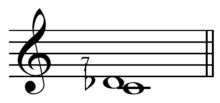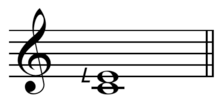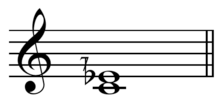7-limit tuning
7-limit or septimal tunings and intervals are musical instrument tunings that have a limit of seven: the largest prime factor contained in the interval ratios between pitches is seven. Thus, for example, 50:49 is a 7-limit interval, but 14:11 is not.




For example, the greater just minor seventh, 9:5 ![]()
![]()
The Great Highland Bagpipe is tuned to a ten-note seven-limit scale:[3] 1:1, 9:8, 5:4, 4:3, 27:20, 3:2, 5:3, 7:4, 16:9, 9:5.
In the 2nd century Ptolemy described the septimal intervals: 7/4, 8/7, 7/6, 12/7, 7/5, and 10/7.[4] Those considering 7 to be consonant include Marin Mersenne,[5] Giuseppe Tartini, Leonhard Euler, François-Joseph Fétis, J. A. Serre, Moritz Hauptmann, Alexander John Ellis, Wilfred Perrett, Max Friedrich Meyer.[4] Those considering 7 to be dissonant include Gioseffo Zarlino, René Descartes, Jean-Philippe Rameau, Hermann von Helmholtz, A. J. von Öttingen, Hugo Riemann, Colin Brown, and Paul Hindemith ("chaos"[6]).[4]
Lattice and tonality diamond
| 7/4 | ||||||
| 3/2 | 7/5 | |||||
| 5/4 | 6/5 | 7/6 | ||||
| 1/1 | 1/1 | 1/1 | 1/1 | |||
| 8/5 | 5/3 | 12/7 | ||||
| 4/3 | 10/7 | |||||
| 8/7 |
This diamond contains four identities (1, 3, 5, 7 [P8, P5, M3, H7]). Similarly, the 2,3,5,7 pitch lattice contains four identities and thus 3-4 axes, but a potentially infinite number of pitches. LaMonte Young created a lattice containing only identities 3 and 7, thus requiring only two axes, for The Well-Tuned Piano.
Approximation using equal temperament
It is possible to approximate 7-limit music using equal temperament, for example 31-ET.
| Fraction | Cents | Degree (31-ET) | Name (31-ET) |
|---|---|---|---|
| 1/1 | 0 | 0.0 | C |
| 8/7 | 231 | 6.0 | D |
| 7/6 | 267 | 6.9 | D♯ |
| 6/5 | 316 | 8.2 | E♭ |
| 5/4 | 386 | 10.0 | E |
| 4/3 | 498 | 12.9 | F |
| 7/5 | 583 | 15.0 | F♯ |
| 10/7 | 617 | 16.0 | G♭ |
| 3/2 | 702 | 18.1 | G |
| 8/5 | 814 | 21.0 | A♭ |
| 5/3 | 884 | 22.8 | A |
| 12/7 | 933 | 24.1 | A |
| 7/4 | 969 | 25.0 | A♯ |
| 2/1 | 1200 | 31.0 | C |
See also
Sources
- Fonville, John. "Ben Johnston's Extended Just Intonation- A Guide for Interpreters", p.112, Perspectives of New Music, Vol. 29, No. 2 (Summer, 1991), pp. 106-137.
- Fonville (1991), p.128.
- Benson, Dave (2007). Music: A Mathematical Offering, p.212. ISBN 9780521853873.
- Partch, Harry (2009). Genesis of a Music: An Account of a Creative Work, Its Roots, and Its Fulfillments, p.90-1. ISBN 9780786751006.
- Shirlaw, Matthew (1900). Theory of Harmony, p.32. ISBN 978-1-4510-1534-8.
- Hindemith, Paul (1942). Craft of Musical Composition, v.1, p.38. ISBN 0901938300.
External links
- Centaur a 7 limit tuning shows Centaur tuning plus other related 7 tone tunings by others
